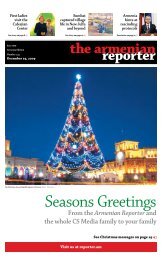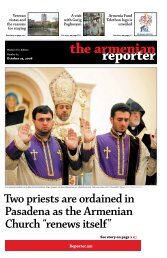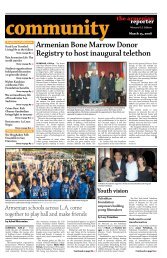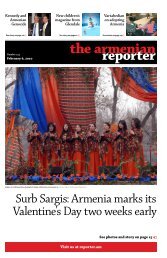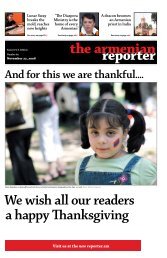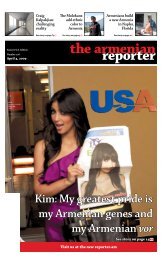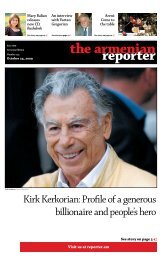You also want an ePaper? Increase the reach of your titles
YUMPU automatically turns print PDFs into web optimized ePapers that Google loves.
the armenianreporterDecember 6, 2008December 6, 2008culture&artsthe armenian reporter&Armine Amiryan:Reporting globallySee page C9AlinaMnatsakanian’ssearch for “home”Page C6GladzorUniversityPage C7Sinfonia Torontocelebrates tenthanniversaryPage C8
ook reviewMe as Her Again: An utterly queer memoirby Shushan AvagyanNancy Agabian, Me As Her Again: TrueStories of an <strong>Armenian</strong> Daughter. AuntLute, October 2008, 243 pages.I met Nancy Agabian for the first timein April 2001, after I read her book PrincessFreak (Beyond Baroque, 2000), whichgreatly impressed me for its audacity.Her small, bold book, which fused poetry,creative nonfiction, and texts fromperformance art, was controversial for<strong>Armenian</strong> society because it exploredthe polymorphous and elusive natureof identity and dared to openly speakabout sexuality – something that rarelysurfaced in a literary tradition that wasoverwhelmingly dominated by male andheterosexual discourses.Released in October, Agabian’s newbook, Me as Her Again: True Stories of an<strong>Armenian</strong> Daughter, was eagerly awaitedby her fans in America, Europe, andArmenia. It is a memoir about identityand family history that Agabian workedon for over six years. It is also, perhapsin the vein of David Sedaris, a brazenexamination of queerness – a deviationfrom the expected, the norm, and theconventional – through a discovery of aqueer self, the hilarious attempt to denyit through self-banishment, and, finally,the recognition and acceptance of that“odd” self.The opening of the book sets a tonereminiscent of the introductory sceneof Eve Ensler’s The Vagina Monologues:“I bet you’re worried. We were worried.”In Agabian’s book, however, the toneis even more urgent and insistent, asa grandmother addresses her granddaughterin a letter that begins like this:“Dear Nancy: I’m still worrying aboutyou.” Unlike Ensler’s women, who speakin unison, echoing one another and assertingtheir needs, the 87-year-old Zanikin Me as Her Again is running out oftime (“I’m worrying, I’d like to go home,you know, they won’t take me there”)and space (“I have a lot to say but can’ttell you in the letter”). “No more,” shewrites in a postscript with regard to herterse, almost frugal letter, “we’re notmaking a newspaper, you know.” Here isan urgent message that ironically refusesto broadcast its exigency, that’s stillanticipating a possibility of change andneeds our attention now.Zanik’s request remains unanswered.How might Nancy have responded to awoman who years ago, as a child, hadbeen displaced from her home, and nowyearned to go back? What worried hermost: the reason that her granddaughterwas in self-exile or that she (Zanik)wasn’t free to return home? WhatShushan Avagyan is a doctoral student in Englishand comparative literature at Illinois State University.She has translated a volume of poetry byShushanik Kurghinian and a book on plot by ViktorShklovsky.<strong>Armenian</strong> <strong>Reporter</strong> <strong>Arts</strong> & <strong>Culture</strong>Copyright © 2008 by <strong>Armenian</strong> <strong>Reporter</strong> llcAll Rights ReservedContact arts@reporter.am with announcementsTo advertise, write business@reporter.am or call 1-201-226-1995compelled her to reach out to her errantgranddaughter? But no word followsher declaration of transfer. The silenceis profound, more profound than themeaning of the ambiguity of her letter.Then this silence is gradually and painstakinglyfilled with Nancy’s narrative – asearch for ways to grapple with a legacyof genocide, to seek acceptance and recognitionin her own family that deniesher sexuality, and to fully exist and takepart in two worlds (the <strong>Armenian</strong> andthe American) that seem to exist in contradictionwith one another. These internalconflicts are further established in achapter titled “Two-headed bird,” whereAgabian reveals the hidden meaning ofher memoir’s title – Me as Her Again ishomophonous with the word miaseragan,which means homosexual in <strong>Armenian</strong>.In a different chapter, Agabianexplains: “The truth was, Grammy hadmanaged to do both with me – be herselfand love me unconditionally.”Agabian narrates hilarious, strange,and elegiac stories about her sister,who moves to Northampton to live ina women’s commune and comes out toher family as a lesbian; about her homophobicbrother who comes out of thecloset later in life; and, finally, abouther parents, who are clueless that theiryoungest daughter is writing performancepieces about their dysfunctionalfamily.Agabian’s prose is playful, as it shiftsfrom extremely serious to almost farcical.One of the strongest aspects ofthis book is the author’s ability to takesomething as outrageous as, for example,being confronted by someone in theaudience who has completely missedyour art, and narrate it in such a waythat is at once comical and ironic. Hereis a classic Agabian, wearing a costumeof thin white cotton pajamas, facing apacked house of <strong>Armenian</strong>s in the tinyback room of a café in Pasadena: “Theywere close enough to hear my heartbeating. Attempting to manufacture anemotional distance, I looked into theback row and announced in a stage voice,‘This performance is called The CrochetPenis.’ A woman in her late 40s, sittingto my right, our knees almost touching,said with an accent, ‘Ugh, why they haveto call it that?’ to no one in particular.”Later in the performance the womanstands up and demonstratively leavesthe room.A few days later the same womandisrupts another performance titledWANT at the Glendale Public Library:“It was not serious poetry, it was moreof a low-class comedy act... I am a literatureprofessor!” she yells. “I know whatI am talking about. I could have told youin private, but I wanted everyone tohear my opinion.” As Agabian confesses,the woman’s reaction is her “worstnightmare come true.” Ironically, thisoutbreak is followed by an earnest discussionabout taboos and the audienceengages in an insightful conversationabout silences surrounding sexuality in<strong>Armenian</strong> society. This all-too-familiarscene implicitly alludes to similar occasionswhen lectures or panels aboutthe <strong>Armenian</strong> Genocide are disruptedby deniers in the audience and demonstratesthe importance of a supportivecommunity.Through her stories, Agabian addressesissues that have worried and still worryher today. But unlike Zanik or her mother,who only told their stories of loss andsurvival to their own children, Agabian istransmitting her (and their) stories to anOn page C1: One of Armenia’s most visible reporters, Armine Amiryan isspending six months with U.S.-Armenia TV in Burbank, Calif., as specialcorrespondent. She says she hopes to explore social problems and otherissues during this time. Photo: Stepan Partamian. Story on p. C9.Nancy Agabian.audience of strangers – people who shehopes are receptive and capable of listeningand responding adequately to herconcerns. Me as Her Again is remarkablein its driving force to truthfully speakabout unspoken things, its sensibilitythat is at once comical and empathic, andits persistent refusal to expurgate partsof a vibrant voice in order to fit in withthe collective stories of our ancestors. Your news goes right hereSee an “ian” on the credits? Watch aHye on your local news? Write the <strong>Reporter</strong>,and we’ll get crackin’ to profilethe son or daughter of Hayk in an upcomingissue.Point and click an ‘e’ toarts@ reporter.am (dot am on the‘net is for all things <strong>Armenian</strong>!).connect:arts@reporter.amC2 <strong>Armenian</strong> <strong>Reporter</strong> <strong>Arts</strong> & <strong>Culture</strong> December 6, 2008
essayTwenty Decembers ago, life was brutally cut shortIn memoryby Armen D.BaconMy husband’s uncle, Uncle Milton, oncewrote our family a note that said, “We<strong>Armenian</strong>s are prone to great suffering.”At the time, he was responding to a singularloss of a loved one. A child. Ourson. Somehow, in the body of his letter,he tried to explain that this one loss reopenedthe wounds of all of our people.When one is wounded, the blood drains fromall of us.Hearts ache in unison. An <strong>Armenian</strong>perishes in some distant corner of theuniverse and <strong>Armenian</strong>s everywherefeel it. The never-ending and perpetualgrief cycle somehow begins all overagain. Uncle Milton didn’t elaborate,but, in all of his infinite wisdom, I thinkhe wanted us to know that <strong>Armenian</strong>sacross the world were wrapping theirarms around us in comfort during ourtime of need. He also, I believe, was tryingto convey that we would survive thisordeal, this unimaginable loss – just asour ancestors have endured great tragediesthroughout history. There had beenwars, genocide, and, more recently, theearthquake. He closed his letter by remindingus that, as <strong>Armenian</strong>s, we possessan unwavering spirit, one that cannotbe shattered or shaken. Not even byan earthquake with a magnitude of 6.9.It is a well-documented fact that <strong>Armenian</strong>shave suffered more than theirfair share. Just sit in any <strong>Armenian</strong>church on a Sunday morning and observethe depth of sorrow and whimpersthat can be heard from the pews– watch the church elders as they lowertheir heads in sorrow while the DivineLiturgy and music remind them of lostloved ones. Our losses, whether freshor ancient, occurring here in Americaor somewhere else, are somehow connectedand intertwined.When the earthquake hit in the late80s, life on this side of the planet wassweet and simple. My own children, atthe time, were in grade school, both ata magical age of innocence. Our parentswere still alive and healthy, and, quitegenerally speaking, there was less pollution,more time for friends and family,little to no technology to distract usArmen D. Bacon is senior director for communicationsand public relations for the Fresno CountyOffice of Education and a regular contributor to the<strong>Armenian</strong> <strong>Reporter</strong> (See profile December 8, 2007).Ms. Bacon lives in Fresno, California, and is a wife,mother, professional woman, and writer. Since2004, her thoughts and reflections about life havebeen published in the Valley Voices section of TheFresno Bee. She also writes, produces, and hosts aradio series titled “Live, Laugh, Love” on Fresno’sK-JEWEL 99.3 radio. She can be reached atarmendbacon@aol.comfrom the human side of life, and, despitethe normal trials and tribulationsof daily life, it was a time of pure andsimple abundance.Life changes in an instant. The quakehit on December 7, 1988, at 11:41 a.m.local time in the city of Spitak in Armenia,killing at least 25,000 children andadults. Although initial reports weresketchy at best, the headline news hadbeen announced and <strong>Armenian</strong>s everywherewere militant in wanting to riseup to offer aid and come to the rescue oftheir families and loved ones abroad.The local <strong>Armenian</strong> churches and reliefsocieties immediately began collectingmoney and clothing and became a clearinghousefor information about lovedones. Special church services and prayerofferings for the lost, wounded, or nowhomelesswere being chanted aroundthe clock. Long-distance calls acrossthe ocean beckoned word of safety andwell-being. But to everyone’s chagrin,power sources were down, communicationsterribly hampered, and for daysCalifornia residents received little if anyThe headline newshad been announcedand <strong>Armenian</strong>severywhere weremilitant in wantingto rise up to offer aidand come to the rescueof their families andloved ones. Photos:Photolure.word of relief efforts to find their families.Conversations with neighbors, relatives,church officials, and God tookplace nonstop, hopeful of encouragingnews. We awaited lists of survivors,heard miraculous stories of survival,but as details eventually unfolded, welearned that the injuries were staggering,mainly because dismally shoddybuildings had resulted in one of theworld’s worst-ever quake disasters.It’s difficult to imagine a loved onetrapped in a collapsed building, woundedin rubble, wandering aimlessly insearch of other family members. Howgrateful we would suddenly become,tucking our own families into bed atthe end of the day, wrapping ourselvesin warm blankets, taking refuge in oursolid and well-constructed ranch-stylehomes, with peace of mind of our ownsafety and well-being. There is little justicein the world.Those first photographs were horrific.It’s odd to admit, but you first look atthe faces. When it’s another <strong>Armenian</strong>,you immediately feel this compellingneed to act. This could be your brotheror sister, an aunt or uncle. You see theprominent features, the olive complexions.Then your eye takes in the surroundings.The sights of cities destroyed,schools demolished, medical facilitiesleveled, and the sounds of people crying,weeping, even moaning as theysearch for loved ones and signs of life.The statistics underscored the devastation– 25,000 killed, 15,000 injured,517,000 people homeless. To add insultto injury, the disaster hit on a day ofextremely cold temperatures. “Asdvadz,”I remember my Auntie Mary repeating,as she made the sign of the cross. Overand over again. It took days for her familyto confirm the safety of her cousinswho lived in one of the nearby villages.When you live in Fresno, a city by andlarge protected from the wrath of MotherNature, it is difficult to imagine suchdevastation. In the days and weeks tofollow, we collected money and clothing,delivering them to the church wherethere were assurances that they wouldreach those in need.A few years later, I met a family fromGyumri whose arrival to Fresno broughtstories of remembrance and words ofgratitude. The villages had been hard hit.The tremor had leveled schools. Zohrab,who spoke very little English, recountedthe story with tears streaming down hisface. The plight of his people had madehim decide to come to California tostart a new life. The gifts of support hadgiven him promise of a new and betterlife for his family. Many years ago, he,too, had lost a child. The earthquake hadfurther shaken his world. I marveled athis strength and courage, his unwaveringoptimism that life could be better inthe United States. I reread my uncle’s letterthat evening, quickly reminded thatwhile we are a people prone to great suffering,we are also a people who will risefrom the ashes to rebuild and renew ourlives.Armen Bacon’s essay is part of a series inthe <strong>Arts</strong> & <strong>Culture</strong> section that feature shortcreative fiction and nonfiction pieces fromour community of readers. For consideration,submit your original work to arts@reporter.am<strong>Armenian</strong> <strong>Reporter</strong> <strong>Arts</strong> & <strong>Culture</strong> December 6, 2008C3
essayThe masala (spicy) <strong>Armenian</strong>sby Mary TerzianMary Terzian is a freelance writer residing inCalifornia. She is the author of The Immigrants’Daughter.“You know I’m going to India,” dropped afriend, during a casual conversation.“No, I didn’t. What for?”“There’s a pilgrimage to the <strong>Armenian</strong>churches there.”“I wanted to go too but it’s too latenow.”“Try this number and see.”So I did, without a second thought ora review of the itinerary. It was an excellentopportunity to visit India but rathera rash decision, ten days before finaldeparture, without an airline booking ora visa. I don’t fly off to unknown landson impulse but the offer was attractiveand I needed an escape. Call it travelosisif you will.Friends were shocked as much as Iwas.“India? What for? Did you run out ofcountries to visit?”Granted, India may not sound as adventuresomeas a Himalayan hike, or acruise on the Amazon into the jungle,much less like a romantic escapadeto Paris, but I had a compelling reason.The Supreme Head of the <strong>Armenian</strong>Orthodox Church, His HolinessKarekin II, was going to re-consecraterenovated churches, inaugurate the refurbishmentof the <strong>Armenian</strong> Collegeand Philanthropic Academy under newmanagement, and celebrate the 300thanniversary of the establishment of the<strong>Armenian</strong> Holy Church of Nazareth inCalcutta, now Kolkata.The 300th anniversary is no mistake.The dates are verifiable on the gravesin the adjoining cemetery. The deaddon’t lie. It appears that <strong>Armenian</strong>shad established a thriving communityin Calcutta and thereabouts, and werein business “some sixty years beforeBritish adventurers became establishedtraders” there, extending their activitiesall the way to the Philippines. Theywere merchants, not conquerors. Theyhad the lucidity and foresight to establisha community complete with church,school through college, and the first <strong>Armenian</strong>newspaper in print, also serving<strong>Armenian</strong> students from other cities inIndia, Iran, Armenia and now Iraq - sortof the Eastern equivalent of the MelkonianInstitute in Cyprus.Travel to India is not for the faint ofheart. Overpopulation, pollution, congestionamong carts, bicycles, rickshawson tricycles, motorized three-wheelvehicles, regular taxis and buses, allclaiming the right of way among pedestrians,beasts of burden, weight-carryinghumans, and cows create a chaos oftraffic germane to Third-World countries.Honks are ineffective. Under thecircumstances, driving a tourist busthrough narrow streets, within an inchof other users of the road, is a risky andat times hair-raising experience. It tookme a week to realize that Indians driveon the left side of the road.Our group of 22, give or take a fewduring different legs of our trip, includedfour former students from the<strong>Armenian</strong> school, and a family of eightgoing back for a homecoming. The ageof travelers spanned six years to seniorsover 70, mostly <strong>Armenian</strong>-Americansfrom across the United States, a gentlemanfrom England stationed in Germany– one of the former students – and acouple from Vienna. We had the perfectopportunity and sample to test if theadage “the best way to assess one’s personalityis either to travel with him/heror play a competitive game” was on target.There was the cheerleader, pipingout familiar <strong>Armenian</strong> tunes refreshingour faded memories, the gatekeeperfor rules, the romantic, the incurable“shopoholic,” busy even at pit stops, theentrepreneur, the organizer, the intrepid,the quiet mouse. Further probesinto our roots revealed other hyphens– ex-Egyptian, ex-Bulgarian, ex-Rumanian,etc. – creating a chart of Easternand Western <strong>Armenian</strong> dialects seasonedwith Hindi, Farsi, English, Turkish,and Arabic, in short a masala (spicy)group. Daily interaction adjusted us toeach other’s singularities, accommodatingthe noisy, the tardy, the bossy, thefunny. We quickly surmounted our languageand character differences too. Wewere a resilient group of Hyes after all.Although tourism was not our mainfocus, we did visit the old and newer,sophisticated, quarters of Delhi, ridecamels in Mindawa, hop over elephantsto a mountain top, visit the famous TajMahal in Agra and other ancient palaces,attend dinner in a maharaja’sresidence, and thereafter proceed toKolkata, where Catholicos Karekin IIand his entourage, the 27-member EchmiadzinChoir, and <strong>Armenian</strong>s fromIran, England, Armenia, and Australiawould congregate to celebrate the recentrenovation of five churches in the <strong>Armenian</strong>-Indiancommunity. Little did Iknow that I had signed up for a once-ina-lifetimeevent!Our 16-hour overnight trek by railto Kolkata will certainly be a story totell posterity about. Sleeping in proximityon stacked beds behind curtains,through the dark of the night, whenwhispers, snores, telephone calls, andthe squeaking wheels of the rails gainextra volume, the privacy of homeseemed like a distant dream. The uninitiatedbaby-boomers among us certainlyshrieked at the Indian-style sanitaryamenities common to developingcountries. Though the comfort level wasreasonable by local standards, the elementof surprise magnified the extentof the hardships.The highlight of our trip was aheadin Kolkata, following the footsteps ofCatholicos Karekin II, to the renovatedchurches in Chennai and Tangra, andthe <strong>Armenian</strong> College in Kolkata. Eachone of them kept impeccably clean,stood out in beauty, order and serenity,in sharp contrast to the disarray in theneighborhood. After each event, membersof the local <strong>Armenian</strong> communityoffered their graceful hospitality, all theway to Saidabad, a seven-hour trek fromKolkata each way, due to traffic and potholes– a very bumpy trip that made ahash of our bones.It was, indeed, God’s little acre onearth, home to the Aivazian family in ourgroup. The driver’s maneuvers to parkthe bus were akin to “passing a camelthrough the eye of a needle.” Of coursewe were within the sacred compoundof church grounds and any miracle waspossible. A delicious lunch served afterthe services under a tent set up outside,in the idyllic setting by the lake,revived our energy for the return trip.The final evening banquet, at Taj BengalHotel, topped the list in elegant dining,with the Catholicos and guest dignitariescongratulating the <strong>Armenian</strong>-IndianLeft: Travel to Indiais not for the faint ofheart. Overpopulation,pollution, congestionamong carts, bicycles,rickshaws ontricycles, motorizedthree-wheel vehicles,regular taxis andbuses, all claiming theright of way amongpedestrians, beastsof burden, weightcarryinghumans, andcows create a chaosof traffic germane toThird-World countries.Below: Mary Terzian.community for the monumental taskof regenerating their existence. Experiencegained during our outbound trip toKolkata made the return to Delhi almostpleasant.In retrospect, the sharagans (hymns)we sang in the churches with the EtchmiadzinChoir sparkle in memory. Inthese remote (for us) churches, as werecited our “Hayr Mer,” dressed in saris,Western-style clothes or loose Easternstylegarments, the famous lines of poetVahan Tekeyan, “The <strong>Armenian</strong> churchis the birthplace of my soul,” hoveredin my mind. We stood united in faith.We could not but express our appreciationand our awe to the dwindling<strong>Armenian</strong>-Indian community of 80 inKolkata, and to the student body, foroffering us this opportunity of communionwith them, and for preserving ournational character and heritage. Theystand tall as viable members of the <strong>Armenian</strong>Diaspora.We were strangers when we startedour trip. After our fellowship of 18 daysthrough thick and thin, from regal accommodationsto cramped quarters,from modern conveniences to sub-standard(per Western outlook) amenities,from palatial residences to local bazaars,and from luscious meals to snacks onthe run, we had become family, till deadlinedid us part.Will I visit India again? I doubt it. WillI go looking for <strong>Armenian</strong>s in the SouthPole or in Timbuktu? Perhaps. Right nowI will attend to updating my list of valuablenew friendships.C4 <strong>Armenian</strong> <strong>Reporter</strong> <strong>Arts</strong> & <strong>Culture</strong> December 6, 2008
<strong>Armenian</strong> <strong>Reporter</strong> <strong>Arts</strong> & <strong>Culture</strong> December 6, 2008C5
House on Wheelscritics’ forumAlina Mnatsakanian’s search for “home”by Ramela GrigorianAbbamontianLOS ANGELES - How do <strong>Armenian</strong>s,having crossed a number of borders andencountered many homes, construct adiasporic identity? Can the diasporic <strong>Armenian</strong>live in one place and still be partof another – a historic homeland, a siteof origin, a prior home? Post-colonialtheorists Bill Ashcroft, Gareth Griffiths,and Helen Tiffin, in defining “exile” withregard to diasporic peoples, wonder if“home” is in “the place of birth (nateo),in the displaced cultural community intowhich the person is born, or in the nation-statein which this diasporic communityis located” (Key Concepts in PostcolonialStudies. London and New York:Routledge, 1998, p. 93). These are questionsthat burden many <strong>Armenian</strong> artistsas well, including Alina Mnatsakanian.Mnatsakanian’s installations havebeen exhibited and her performancepieces have had a run in Los Angelesover the last several years. Her workcontinues to live online, asking questionswe have yet to answer. It engagesthe issues of “home” and “homeland” aswell as the incessant movement acrossborders and the encountering of manycultures. Mnatsakanian’s personal historyinspired many of her pieces: shewas born and raised in Iran (to Russian-<strong>Armenian</strong> and Iranian-<strong>Armenian</strong> parents)but left for Paris at the onset of theIranian Revolution in 1979. After pursuingan art education in Paris for severalyears, she settled in Los Angeles in 1983.After 22 years and several sporadic tripsto Armenia, she relocated once more, inSeptember 2005, to Switzerland.Mnatsakanian’s installation, Houseon Wheels (2000), confronts the issue ofconstant movement and hybrid identity.The installation incorporates a woodenstructure, audio recordings, and projectedimages on the wall, all of whichtogether create a multi-media and multisensoryspace of engagement. Hanginginside the house-shaped wooden frameare four large transparencies representinghomes and cultures the artist hasencountered: Iran, France, the UnitedStates, and Armenia. Each home is referencedwith very specific iconography,which includes such things as identificationcards, passport photos, metromaps, visas, and citizenship papers – allof them signifiers of movement, belonging/notbelonging, and the creation of“home.”Mnatsakanian considers her “homeland”Iran as well as Armenia, explaining,“It’s like a kid who has divorcedRamela Grigorian Abbamontian is an assistantprofessor of art history at Pierce College. She is alsoa Ph.D. candidate in art history at ucla. You canreach Abbamontian or any of the other contributorsto Critics’ Forum at comments@criticsforum.org. This and all other articles published in this seriesare available online at criticsforum.org. To signup for a weekly electronic version of new articles,go to criticsforum.org/join. Critics Forum is a groupcreated to discuss issues relating to <strong>Armenian</strong> artand culture in the diaspora.Alina Mnatsakanian’s personal history inspiredmany of her pieces.parents,” referring to the sense of attachmentone feels to more than oneplace (home) and implying an involuntaryseparation from an initial source oforigin. Even though Mnatsakanian citesher strongest connections to her birthplaceof Iran and to Armenia (noticeablythe most colorful transparencies), shehad created the home structure for Armeniawithout ever having visited thecountry – emphasizing my earlier suggestionthat “homeland” is an imaginedplace for many <strong>Armenian</strong>s. When theimagined place was transformed into areal one during her first visit, in 2001,ATWATER VILLAGE, Calif. - “DefiningPlace,” a group show exploring how artistsdefine their identity in terms of connectionto place, opens at the Center forExperimental Art and Architecture onFriday, December 5. The exhibit will beon display through December 15.“Defining Place” asks its audienceif home is simply a residence ofrefuge and safety or there are multipledefinitions of this term. Whatare the different kinds of connectionsto place, and how are definitionsof home and people’s connectionsto place shifting or changing?“Defining Place” brings togetherartists from across the UnitedStates who view their respectiveenvirons in unique ways.Ara Oshagan’s “Juvies” series exploresthe daily lives of a group ofincarcerated high-risk juvenile offendersin Southern California.Gilda Davidian’s “Portrait Studio”images highlight Los Angeles studiophotographers within their ownstudios and also include interiorimages of these spaces themselves.Also featured are the works ofBenjamin Donaldson, MichaelCappabianca, and Paul Typaldos.Mnatsakanian’s installations engage the issue of “home” and “homeland” as well as the incessantmovement across borders and the encountering of many cultures.Mnatsakanian recalled: “I kind of feltlike I had been there before, like I belongedthere.”Mnatsakanian’s structure is merelythe frame of a house – no walls, no roof,no foundation, no other reinforcements.The skeletal structure, transparent houses,and the fact that it is on wheels oncemore point to the impermanent andmobile nature of the diasporan, whohas changed homes a number of timesand whose identity, even in the present,is still not fixed. Interestingly, R. B.Kitaj, an American-born artist of Jewishdescent living in England, suggestsCurator Tamar Salibian, filmmakerand cultural studies doctoral studentat Claremont University, will introducethe exhibit on opening night.The evening will feature a performanceby Slow Motion Reign’s VigenSayadian.connect:ceaasite.combrudian.com(818) 551-9386a similar experience of immigrant lifeas displacement, quite apart from actualphysical or geographic movement.In First Diasporist Manifesto (1989), heexplains that his identity was “bornfrom the amalgamation of dislocation,rupture, and a hybrid self which exists– and paints – in two or more societies atonce.” Clearly, the sense of a displacedidentity is not exclusive to the <strong>Armenian</strong>diaspora – it reflects the larger immigrantexperience.Mnatsakanian’s installation layers“Defining Place” exhibition opens December 5“Baracoa” by Paul Typaldos.Continued on page C7 “Defining Place”Opening: Friday, December 5, 2008, 7:00-10:00 p.m.Center for Experimental Art and Architecture3191 Casitas Ave, Suite 138, Los Angeles,CA 90039Donation: $10 (proceeds benefit Centerfor Experimental Art and Architectureprograms)Exhibit available for viewers by appointmentonly December 5–15.C6 <strong>Armenian</strong> <strong>Reporter</strong> <strong>Arts</strong> & <strong>Culture</strong> December 6, 2008
historyGladzor U.: A proud moment in <strong>Armenian</strong> historyby Nyree AbrahamianYEREVAN – If you could go back to onetime and place in <strong>Armenian</strong> history, onethat you’re really proud of, what would itbe? The heyday of the Urartian Kindgomin the 8th century b.c.e.? Etchmiadzin inthe early 4th century., during the foundingof the Mother See? Yerevan in thelate 1980s, at the height of the <strong>Armenian</strong>national movement? I can’t pick just one,but high on my list of moments in ourhistory to revisit is Gladzor University inthe 13th century.True, as a woman, I probably wouldn’thave had the right to study under thegreat masters there, but I highly doubtthat women anywhere in the world hadthe right to higher education in the 13thcentury. The political, religious, and artisticbreakthroughs that emerged fromthis academic institution make it just asimportant as any battleground in thedefense and advancement of the <strong>Armenian</strong>nation.<strong>Armenian</strong>s have a long and impressivetradition of groundbreaking universitiesthat started in the 5th century(the Golden Age of <strong>Armenian</strong> literature)when Mesrob Mashtots and his disciplesfounded schools throughout the nationto teach the new alphabet and promotea heightened sense of <strong>Armenian</strong> spirituality.Modern secular universities did notemerge in Europe until the MiddleAges. While Armenia’s early universitieswere by no means secular, whatreally set them apart as forwardthinkinginstitutions was the fact thatthey had “faculties,” comprised of severalscholars who were organized into“departments” based on their fields ofspecialization. At a time when universitiesin England, France, and Italyconsisted of one person who was saidto be a “master of all knowledge,” <strong>Armenian</strong>academic institutions wereorganized in a fashion quite similarto modern universities, with departmentslike astrology, philosophy, theology,and art, taught by specialists ineach field.Despite centuries of foreign domination,universities throughout ArmeniaContinued on page C11 Tanahat Monasteryin Vayots Dzor, wherehistorians believeGladzor Universitywas founded.House on Wheels: Alina Mnatsakanian’s search for “home” Continued from page C6this sense of displacement into her installation.A ten-minute video loop,evoking the notion of home and movementthat are central to the installation,is projected onto the back wall, castingthe structural form of the house itselfon the wall. The video is a layered collageof various scenes with a superimposedaudio component – giving the viewer amulti-sensory experience similar to thedisorientation engendered by displacement.Mnatsakanian’s own voice playsin the background, her words oftenmuddled, disrupting any sense of clarityand denoting, as the artist herselfwrites, “confusion related to the multiculturalexistence.”In the audio portion of the installation,the artist briefly recounts thespecific experience related to each respectivecountry: a childhood in Iran;art school in France; adulthood inAmerica; and an imagined home in Armenia.These narratives are deliveredin the languages of the specific countryand include a corresponding songin the background. Mnatsakanian alsorecites the following quote by the Iranian-born<strong>Armenian</strong>-American authorHagop Karapents in all four languages– <strong>Armenian</strong>, Farsi, French, and English– identifying her many homes: “Everyonegoes from one place to another toget home. Some people who go fromone place to another never get home.Some others get home, but always stayin exile.”The key images projected on the backwall reinforce the notion of constantmovement and the attempt to create ahome. The identification card is the identifyingmarker of newcomers to the UnitedStates. Its rather paradoxical monikerAlina Mnatsakanian’s installation, House on Wheels (2000), confronts the issue of constant movementand hybrid identity.– “Resident Alien” – denotes someonewho lives in the States but does not quiteyet enjoy the full benefits of citizenship,in other words, one who does not quiteyet belong. The next segment shows therepeated movement of a pair of handsputting up a miniature house, its collapse,and its rebuilding – the narrative looprepresenting visually the many homesbuilt and rebuilt by diasporans.In the following segment, people atUnion Station, in downtown Los Angeles,are hurriedly walking from oneplace to another. The final projection isof a set of hands protectively and reverentiallycupping soil. Could this beMnatsakanian’s – or any diasporan’s– attempt to capture a piece of the land,to render it a “homeland?” Or does it expressthe desire to claim a certain landas one’s own, in a paradoxical attemptto halt the movement inherent in thediasporic experience?In the statement describing the installation,Mnatsakanian elaborates on thistemporality, uprootedness, and the endlesssearch for a “home:”... Sense of belonging to a place, ahome or a homeland, is a natural feeling.When one abandons the homeland,the sense of belonging becomesabstract and sometimes unattainable.Duality or plurality is a feeling createdin such circumstances as a result ofvarious cultural influences. It can beenriching, yet differences and contrastsmay also create confusion. Aperson with a multi-cultural upbringingmight feel alienated in a societythat is prominently from a single culturalbackground. One way of facingthis issue is to completely conformto the new culture. Another way is tofind a possible coexistence.Mnatsakanian, it seems, recognizesthe challenges of multiple belongingultimately by embracing her diasporanidentity as multi-dimensional, what wemight call a “transnational” self inhabitingseveral identities at once.House on Wheels has been exhibited atNeuchâtel, Switzerland; California StateUniversity, Los Angeles; and the SamFrancis Gallery (Crossroads School, SantaMonica). You can view Mnatsakanian’sart on her website at alinamn.com. All Rights Reserved: Critics’ Forum, 2008. Exclusiveto the <strong>Armenian</strong> <strong>Reporter</strong>.<strong>Armenian</strong> <strong>Reporter</strong> <strong>Arts</strong> & <strong>Culture</strong> December 6, 2008C7
film“Kin” International Film Festival showcases filmswritten and directed by women around the worldby NyreeAbrahamainYEREVAN – The Fifth Annual “Kin” InternationalFilm Festival, which showcasesthe talents of women directors throughoutthe world, took place between November28 and December 2 in Yerevan.The festival was organized by Liza Foundation,an <strong>Armenian</strong> non governmentalorganization that aims to protect women’srights and support women’s participationin the social and political life ofArmenia through the promotion of cultureand education.Fittingly, the festival opened just a fewdays after the International Day for theElimination of Violence against Womenon November 25, when women’s rightsand human rights group throughout Yerevanspoke out against domestic violence,an issue the discussion of whichis gradually becoming less of a taboo inArmenia.Fifty films were showcased at the fivedayfestival, from 11 different countriesranging from Iceland to Iran. “Our goalis not to limit the festival to films aboutwomen’s issues,” said “Kin” Festival organizerand director of Liza Foundation,Mariam Ohanyan. “We choose filmsbased on artistic merit. What’s importantis to see women’s viewpoints, to seethe world through women’s eyes.”Liza Foundation, established in 1994,had been working with women filmmakersin Armenia for several years, but theyfound that the largest obstacles that theyfaced was not making the films, but actuallyhaving them viewed. So they startedthe “Kin” Festival in 2004 to showcase<strong>Armenian</strong> women’s films. “In that firstyear, the festival included only the worksof <strong>Armenian</strong> filmmakers that had beenproduced in the past 15 years,” explainedMs. Ohanyan. “But over the years, weexpanded it to a more internationalscale.” Guests at this year’s festival includedMelek Ozman and Elisa Batoni,from Turkey and Italy, respectively, whoare both filmmakers and human rightsactivists. There were five jury membersincluding Canadian Oscar-winning director,Beverly Shaffer.“Kin” International Film Festival washeld at Yerevan’s Puppet Theater andentrance was completely free of charge.There was hardly an empty seat in the“Kin” International Film Festival took place at Yerevan’s famous Puppet Theater. Photo: NyreeAbrahamian.house throughout the festival. I waspleasantly surprised to see a diverse audience,with men and women of all differentage groups in attendance. There wereeven families with small children, whichgoes to show how important a culturalupbringing still is in Armenia. During theopening ceremony, I sat next to a fatherwho was quietly and patiently explainingthe English parts to his seven-year-olddaughter. It was truly heart-warming andencouraging to see that a celebration ofwomen in film was not considered a women-onlyzone, as proof of a traditionallypatriarchal <strong>Armenian</strong> society becomingincreasingly open-minded and of a senseof empowerment being instilled in a newgeneration of <strong>Armenian</strong> women. Sinfonia Toronto celebrates tenth anniversary with Germany tourby Migirdic MigirdicyanTORONTO – Sinfonia Toronto, the premierchamber orchestra of Toronto, underthe baton of Nurhan Arman, completedits first international tour by givingfive concerts in Germany.The first concert of the tour, on November19, was held in Fulda, followedby performances in Kassel, Warburg,and Bensheim. The series ended on November23 with a concert at the beautifulSt. Gallus church in Florsheim.The 13-piece string orchestra performedworks by Elgar, Schubert, Dvorak,Janacek, MacMillan, Sarasate, andTchaikovsky, thrilling audiences and receivingcritical acclaim. One newspaperin Fulda wrote, “The conductor let hisplayers do magic.” In Florsheim, aftera performance of Khachaturian’s “MasqueradeValse,” which the orchestraplayed superbly as a second encore, theaudience gave a standing ovation. Later,during a post-concert reception, the localorganizer told the guests that standingovations did not happen very oftenat this venue.Born to <strong>Armenian</strong> parents in Istanbul,Nurhan Arman played his first violin recitalat the age of 13. In 1971 he cameto United States on a Disney Foundationscholarship to continue his studiesat the California Institute of the <strong>Arts</strong>.After several seasons of leading U.S. orchestrasas concertmaster, he began aSinfonia Toronto performing at St. Gallus Church, Florsheim, Germany.Photos: Migirdic Migirdicyan.conducting career that has expandeddramatically.In 1982 Arman moved to Canada toaccept the post of music director of theNorth Bay Symphony and the NorthernMusic Festival. In 1985 he was appointedto the Royal Conservatory in Torontoas a visiting instructor in conducting,and in 1987 named music director ofSymphony New Brunswick.In March 1993 Arman was appointedprincipal guest conductor of the YerevanSymphony in Armenia. In 1998 hefounded the Sinfonia Toronto, which heswiftly built into one of Canada’s finestchamber orchestras.Nurhan Arman and his 13-piece string orchestra after the performance inFulda, Germany.As guest conductor, Arman has ledrenowned orchestras in Italy, Austria,Germany, Hungary, Spain, Mexico, Korea,Lithuania, and Armenia.Sinfonia Toronto performs its Masters’Series at the Grace Church On the Hill,in the Forest Hills district of Toronto,Canada.C8 <strong>Armenian</strong> <strong>Reporter</strong> <strong>Arts</strong> & <strong>Culture</strong> December 6, 2008
televisionArmine Amiryan reports from around the worldby AdrinehGregorianYEREVAN – For many a broadcast journalist,walking through the halls ofcnn’s headquarters in Atlanta with anall-access pass would be a dream cometrue. Being able to work with the industry’stop anchors and learning from theworld’s best international correspondentswould be high points in manyjournalists’ careers, but for ArmeniaTV’s Armine Amiryan they’re only thebeginning.As one of Armenia’s most visible reporters,Armine is always on the go.When she’s not covering the president’sinternational meetings, she’s travelingthroughout Armenia in search ofhuman -interest stories that have yet tobe uncovered.When I met Armine, she was pacingthrough the halls of Armenia TV’sstudios in Yerevan and was certainly inher element. As she led me through thestation’s news room and infinite row ofediting bays, we ended up in her office – aplace which is undeniably her home base.On any given day, <strong>Armenian</strong>s from allaround the world tune in to watch her reportingon important issues that impactArmenia. On this day she’s preparing tomove to Los Angeles, where she’ll reporton diaspora news – a move that’s imperativein this era, when <strong>Armenian</strong> news canno longer be confined to one region.What do you want to be whenyou grow up?Adrineh Gregorian will be spending the next yearin Armenia on a Fulbright grant. You can find herblogging about her experience at Yum Yum on TumanyanStreet.Armine Amiryan in Hollywood.Like many <strong>Armenian</strong> families, Armine’sparents were fond of the idea that theirdaughter would one day become a lawyeror doctor, but Armine had other plans.From a young age she was drawn to journalism.“By tenth grade I was always watchingthe news and was drawn by the fact thatthere was always something changingsomewhere in the world,” says Armine,who likes to be amidst constant change.“I thought I wanted to become a journalist,but couldn’t imagine that I coulddo it.”As high school came to an end, Arminesecretly applied to the journalism departmentof Armenia’s State PedagogicalUniversity and was accepted. Afterone year of studying journalism, she fellin love with the world of television andadded television production as a secondmajor. Armine would eventually go onto graduate with highest honors in bothmajors.Being merely a student proved to beinsufficient for Armine. In her first yearof university, at just 17, she began reportingon youth issues for <strong>Armenian</strong>Public Radio. “At first I started to makeonly cultural reports, and then one daythe head of the news department toldme I should cover social and politicalissues as well,” recalls Armine. “I didn’twant to become a political reporter, butthen I understood that a reporter shouldnever limit herself to covering certaintypes of issues.”Learning beyond theclassroomBy 2000, and still a university student,Armine joined Armenia TV. The decisionto join a burgeoning U.S.-Armenia mediapartnership, where she would havethe support of senior colleagues whohad built successful media careers in theUnited States and Armenia, catapultedher onto the international scene – literally.In the past six months alone, shehas sat on a plane 50 times and has reportedfrom 30 different countries rangingfrom Tajikistan to the United States,with multiple stops in Europe and theMiddle East.Though she was much younger thanher peers, she began to cover politicalissues as an on-air reporter for the 2003presidential race in Armenia. In 2005,she flew to Brussels to study Europeangoverning bodies, including the EuropeanUnion, European Parliament, andCouncil of Europe, of which Armenia isa member.By 2006, she was traveling withPresident Robert Kocharian and ForeignMinister Vartan Oskanian, coveringtheir international engagements,a function she has continued to carryout with the current administration. Iflearning on the job wasn’t enough, shewas also invited by the United StatesState Department to participate in theEdward R. Murrow Journalism Programwith 126 other journalists from aroundthe world.Out of all the applicants from Armenia,Armine was the only one chosento go to Washington and partake in theone-month learning excursion. “At firstit was like a dream,” she says. “You’realways hearing about America, imaginingit to be like a Hollywood film. Onthe other hand, I was there for my profession,which I absolutely love, and forme it was very important to learn andunderstand journalism in the UnitedStates.”While in the United States, Arminemet with heads of abc News, nbc News,and Fox, and came to understand thedifference between the reporting stylesin Armenia and the U.S. “It’s really different,”she says, “because in the U.S.journalists have many more resources.It was very interesting for me. I understoodthe value of my profession.”Armine returned to Armenia and begancovering the Millennium ChallengeCompact, an important moment forU.S.-Armenia relations. What sets Armineapart from other reporters is thatshe was trained beyond the classroomand foreign relations became her forte.Issues involving <strong>Armenian</strong>-Turkish relations,European integration, Turkish-European relations, Nagorno-Karabakh,U.S.-<strong>Armenian</strong> relations, and <strong>Armenian</strong>sin the United States became herexpertise.“I like this field because I can speak topeople in schools, hospitals, and interviewhigh-ranking officials, for example”says Armine. “I want to understand theirperspectives.”In 2007, the State Department offeredanother journalism program,called TV Co-op, and invited reportersfrom throughout the globe to the U.S.to make a film. “After thinking about itfor a while, I proposed to make a filmabout the <strong>Armenian</strong>-American diaspora,[which was created as a consequence]of the Genocide,” says Armine, whowas the only participant chosen fromArmenia. “The film was not only about<strong>Armenian</strong>s that have made names forthemselves, but <strong>Armenian</strong>s who [aresuccess stories], whether they be in therestaurant business or children attending<strong>Armenian</strong> schools, and how theylearned <strong>Armenian</strong>.”Upon her return to Armenia, invitationsfrom around the world came pouringin, including ones from the GermanMarshall Fund, International MonetaryFund, and European Commission, toAmiryan at the cnn headquarters in Atlanta.participate in discussion groups andcover international news.At this time Armine also began preparingreports for cnn. “Armenia TV has aunique collaboration with cnn becausecnn is broadcast in Armenia,” says Armine.“And I started to make reports forcnn World Report on different issues– some political reports and also culturaland social topics.”This summer Armine was invited bycnn to attend special training courses attheir Atlanta headquarters. “It was reallya big surprise for me because I neverthought that one day I would be insidecnn,” she says. “For reporters, it’s likethe highest school.”As Armine explains the experience,her face lights up. “All the doors areopen for you. You can go everywhere.You can even knock on the door of thepresident of cnn.”In Atlanta, Armine studied under famousanchors, took courses in voicetraining, stand-ups, producing, and editing,and began filing reports. “Insidecnn, I began to understand the importanceof my job,” she recalls.Back in Armenia, Armine shared hernewfound knowledge with her colleagues.“I shared everything that Ilearned over at cnn,” she says. “This includedthe stylistic differences betweenjournalism in the U.S. and the style commonto the CIS countries.”“<strong>Reporter</strong>s in Armenia are not as freeon camera; the style is more official,”Armine explains. In the U.S., “reportersare freer and more active in frontof the camera and the viewers want tosee them. They are more hands-on inshowing the viewer the problems theyare covering. The Western style is slowlybeing adopted across the world and Armeniawill accept this style eventually.The stories must be about the people.Not just official news.”News that impact livesFor the past few years, Armine has madeseveral reports about the people in Armenia.She has traveled throughout thecountry’s rural areas and has immersedContinued on page C10 <strong>Armenian</strong> <strong>Reporter</strong> <strong>Arts</strong> & <strong>Culture</strong> December 6, 2008C9
Program Grid8 – 14 DecemberEST PST22:00 1:0022:30 1:3023:00 2:000:00 3:001:00 4:002:00 5:002:30 5:303:00 6:003:30 6:304:00 7:004:30 7:305:00 8:005:30 8:306:00 9:007:00 10:008:00 11:008:30 11:309:00 12:009:30 12:3010:00 13:0011:00 14:0012:00 15:0012:30 15:3013:00 16:0013:30 16:3014:30 17:3015:00 18:0015:30 18:3016:00 19:0016:30 19:3017:00 20:0017:30 20:3018:00 21:0018:30 21:3019:00 22:0019:30 22:3020:00 23:0020:30 23:3021:00 24:0021:30 24:308 December 9 December 10 December 11 December 12 December 13 DecemberMONDAY TUESDAY WEDNESDAY THURSDAY FRIDAY SATURDAYBernard ShowLike A Wave (Serial)Snakes & Lizards (Serial)A Drop of HoneyNeighbours (Serial)Tele KitchenMultYO YONewsBari Luyswith Stepan PartamianLike A Wave (Serial)Snakes & Lizards (Serial)Directionswith Rafi ManoukianNewsCool ProgramLike A Wave (Serial)Snakes & Lizards (Serial)Tele KitchenMultYO YOCLONE (Serial)NewsLive From Americawith Ara KazaryanUnlucky Happiness(Serial)Neighbours (Serial)NewsGyanki Keene (Serial)Tonight ShowWith Hovo11 - SerialNewsBari Luyswith Stepan PartamianLive From Americawith Ara KazaryanLike A Wave (Serial)Snakes & Lizards (Serial)Unlucky Happiness (Serial)Neighbours (Serial)Tele KitchenMultYO YONewsBari Luyswith Stepan PartamianLike A Wave (Serial)Snakes & Lizards (Serial)Unlucky Happiness (Serial)NewsBumerangLike A Wave (Serial)Snakes & Lizards (Serial)Tele KitchenMultYO YOCLONE (Serial)NewsLive From Americawith Ara KazaryanUnlucky Happiness(Serial)Neighbours (Serial)NewsGyanki Keene - (Serial)Tonight ShowWith Hovo11 - SerialNewsBari Luyswith Stepan PartamianLive From Americawith Ara KazaryanLike A Wave (Serial)Snakes & Lizards (Serial)Unlucky Happiness (Serial)Neighbours (Serial)Tele KitchenMultYO YONewsBari Luyswith Stepan PartamianLike A Wave (Serial)Snakes & Lizards (Serial)Unlucky Happiness (Serial)NewsCool ProgramLike A Wave (Serial)Snakes & Lizards (Serial)Tele KitchenMultYO YOCLONE (Serial)NewsLive From Americawith Ara KazaryanUnlucky Happiness(Serial)Neighbours (Serial)NewsGyanki Keene - (Serial)Tonight ShowWith Hovo11 - SerialNewsBari Luyswith Stepan PartamianLive From Americawith Ara KazaryanLike A Wave (Serial)Snakes & Lizards (Serial)Unlucky Happiness (Serial)Neighbours (Serial)Tele KitchenMultYO YONewsBari Luyswith Stepan PartamianLike A Wave (Serial)Snakes & Lizards (Serial)Unlucky Happiness (Serial)NewsBumerangLike A Wave (Serial)Snakes & Lizards (Serial)Tele KitchenMultYO YOCLONE (Serial)NewsLive From Americawith Ara KazaryanUnlucky Happiness(Serial)Neighbours (Serial)NewsJagadakri kerinere (Serial)Pakhousd - (Serial)NewsBari Luyswith Stepan PartamianLive From Americawith Ara KazaryanLike A Wave (Serial)Snakes & Lizards (Serial)Unlucky Happiness (Serial)Neighbours (Serial)Tele KitchenMultYO YONewsBari Luyswith Stepan PartamianLike A Wave (Serial)Snakes & Lizards (Serial)Unlucky Happiness (Serial)NewsCool ProgramLike A Wave (Serial)Snakes & Lizards (Serial)Tele KitchenMultYO YOCLONE (Serial)NewsLive From Americawith Ara KazaryanUnlucky Happiness(Serial)Neighbours (Serial)NewsJagadakri kerinere (Serial)Pakhousd - (Serial)NewsBari Luyswith Stepan PartamianLive From Americawith Ara KazaryanLike A Wave (Serial)Snakes & Lizards (Serial)Unlucky Happiness (Serial)11 ( Serial)11 ( Serial)11 ( Serial)MultYO YONewsBari Luyswith Stepan PartamianLike A Wave (Serial)Snakes & Lizards (Serial)Unlucky Happiness (Serial)NewsBumerangLike A Wave (Serial)Snakes & Lizards (Serial)Tele KitchenMultYO YOFathers & SonsNewsBernard ShowBlefYere 1 (ye:re:van)CenturyArmenia DiasporaNewsJagadakri kerinere (Serial)Pakhousd - (Serial)NewsBari Luyswith Stepan Partamian14 DecemberSUNDAYBernard ShowLike A Wave (Serial)Snakes & Lizards (Serial)A Drop of HoneyDiscoveryCenturyArmenia DiasporaFathers & SonsNewsCenturyArmenia DiasporaLike A Wave (Serial)<strong>Armenian</strong> Teletime<strong>Armenian</strong> MovieLike A Wave (Serial)Snakes & Lizards (Serial)TV DuelLove E LeeA Drop Of HoneyDesangounBernard ShowBlefMy Big, Fat <strong>Armenian</strong>WeddingDirectionswith Rafi ManoukianWhen the Stars danceCUBEArmine Amiryan reports from around the world Continued from page C9herself into the lives of people who facecritical issues including lack of accessto technology, clean water, and medicalcare, to name a few. “Again, it’s anotherstory, but you must live with them tounderstand their lives,” she says.“Armenia TV has a huge audience herein Armenia and the people are reallywatching and they are really interestedin social stories,” says Armine. “Storiesabout the people’s lives and the problemsthey have.”Armenia TV is a unique station thatbrings Western media standards to Armenia.It was the first station to introducehigh definition, green screen, andlive shooting in Armenia. “This is helpingus deliver news in a different stylethan others,” adds Armine.Today Armenia TV programs arebroadcast in the CIS, Europe, the U.S.,and elsewhere. “<strong>Armenian</strong>s from differentparts of the world are watching us,”says Armine. “I am responsible for eachreport because I know millions of <strong>Armenian</strong>scan be watching.”In November, she answered a call tothe Armenia TV hotline from a familyin Hrazdan, just one hour outside Yerevan,whose four-month-old baby wason the brink of starvation. Within thehour of the call, Armine was already attheir home and filed the story. Her fiveminutereport resulted in over one hundredcalls from the United States andArmenia, with callers (who ranged frombusinesspeople to people who werepoor themselves) offering beds, food,and money. Even Armenia’s minister ofhealth offered assistance to alleviate thefamily’s dire circumstances.“I especially like these kinds of reports,”says Armine, who was still moved by theexperience. “Because each journalist hasan advantage besides showing the truthand the reality. They must help people.”Every day, Armenia TV’s newsroomArmine Amiryan at work.hotline receives over one hundred callsfrom viewers who have stories waitingto be told, Armine says. “We want tocover reports that are interesting for everyaudience member,” says Armine. “Issuesabout trash, elevators, social problems,and we are covering these stories.People who have had no water for up tofive years and we are coving this, andafter five years these people are gettingwater. It’s amazing.”For Armine, it’s fulfilling when the<strong>Armenian</strong> government responds to theissues. “After each report, we get a responsefrom different ministries,” shesays. “They are calling us and saying,‘Tomorrow we are going to resolve thisproblem.’ And we go back and cover howthe problems are resolved.”When Armine first went into journalism,she understood the professionis not just about telling the news. Shewanted to initiate change for the peopleand this was the perfect means.“<strong>Reporter</strong>s are a tool to help people,”she stresses. “Through us we can resolveproblems, through us we can revealproblems that most people don’t evenknow about. And once people know, theproblems become easier to resolve.”US Armenia TV’s newestreporterArmenia TV’s sister company in theUnited States – U.S.-Armenia TV – will behome for Armine for the next six months,during which she will work as the station’sspecial correspondent. Her reportswill be broadcast around the globe.“Most <strong>Armenian</strong>s think that Americais a dream country, but America has alot of problems,” Armine says. “Even<strong>Armenian</strong>s there have a lot of socialproblems but many <strong>Armenian</strong>s from Armeniacannot even imagine these kindsof problems exist. If we start to coverthese types of stories, to cover the lifeof <strong>Armenian</strong>s in the diaspora – musicians,doctors, politicians, even <strong>Armenian</strong>swho are not famous but are doinginteresting jobs – it will be very interestingbecause each family in Armenia hassomeone in the United States.”Diaspora news is not the only theme onArmine’s agenda. With the recent electionof Barack Obama, the U.S. is noticeablyin a period of transformation andtopics ranging from the current economiccrisis to foreign affairs are issues that willalso interest audiences in Armenia.If you love what you do, itwon’t feel like work“My life is the TV station,” says Armine.“Sometimes I’m a reporter, camera operator,and editor at the same time becauseI love my job.”The best part of journalism for Armineis being in the field. “To be withthe people, to be in the center,” she says.“In places where the news changes veryoften because today around the worldnews changes very often. Today peoplehave the Internet and they receive thenews rapidly. I do everything so that Ican change the way I think because everyday the way news is told changes aroundthe world. People are beginning to deliverthe news through iReports and throughour hotline. People are giving us information,they are working with the TV stations,and everything is always changing.The people are becoming the news, so youhave to change the way you think and Ilike to be where there is always change.”Journalism has taken Armine to placesshe could not have even expected. “I neverimagined that I would be inside the WhiteHouse, that I would be inside the State Department,the European Parliament, that Icould be inside cnn,” she says. “Even now,sometimes when I watch cnn, I think, ‘Iwas there?’ It was like a dream.”“At that time I never thought I would reachso far at such a young age, that this manydoors would open,” Armine continues. “Everyday I learn something new. Now thatI’m going to America, I know I’ll experiencesomething new. I’ve reported from manydifferent countries, but for the first time Iwill be living in a foreign country.”Armine adds, “I think this will be a goodexperience for me because, again, I’ll beworking for <strong>Armenian</strong>s and I’m proud tobe <strong>Armenian</strong>.”connect:usarmeniatv.comarmeniatv.amC10 <strong>Armenian</strong> <strong>Reporter</strong> <strong>Arts</strong> & <strong>Culture</strong> December 6, 2008
Watch Armenia TV on Dish Network. To get a dish and subscribe, call 1-888-284-7116 toll free.Satellite Broadcast Program Grid8 – 14 December8 December 9 December 10 DecemberMONDAY TUESDAY WEDNESDAYEST PST4:30 7:30 News in<strong>Armenian</strong>5:00 8:00 GoodMorning,<strong>Armenian</strong>s6:00 9:00 Bumerang6:30 9:30 When the starsdance-Concert7:50 10:50 Seven Sins-Serial8:30 11:30 Bernard Show9:00 12:00 News in<strong>Armenian</strong>9:25 12:25 Bernard Show10:00 13:00 Blef10:25 13:25 Yere1(ye:re:van)10:50 13:50 Telekitchen11:15 14:15 <strong>Armenian</strong>Diaspora11:40 14:40 Cool Program12:00 15:00 News in<strong>Armenian</strong>12:30 15:30 Fathers andSons13:30 16:30 Blitz13:50 16:50 A Drop ofHoney14:15 17:15 The Pages ofLife-Serial15:00 18:00 News in<strong>Armenian</strong>15:30 18:30 When the starsdance16:05 19:05 Seven Sins-Serial16:50 19:50 Point of view16:55 19:55 UnhappyHappiness - Serial17:35 20:35 My Big, Fat<strong>Armenian</strong> Wedding18:00 21:00 News in<strong>Armenian</strong>18:30 21:30 Cost of life-Serial19:05 22:05 11-Serial19:30 22:30 Bernard Show21:00 0:00 News in<strong>Armenian</strong>21:20 0:20 The <strong>Armenian</strong>Film23:00 2:00 Cost of life-Serial23:30 2:30 Telekitchen0:00 3:00 Yere1(ye:re:van)0:25 3:25 A Drop ofHoney0:50 3:50 voa(The Voiceof America)1:10 4:10 Blitz1:25 4:25 Cool sketches1:45 4:45 When the starsdance2:10 5:10 Seven Sins-Serial2:50 5:50 The Pages ofLife-Serial3:35 6:35 Candid cameraEST PST4:30 7:30 News in<strong>Armenian</strong>5:00 8:00 GoodMorning,<strong>Armenian</strong>s5:55 8:55 Point of view6:00 9:00 Bumerang7:25 10:25 My Big, Fat<strong>Armenian</strong> Wedding7:50 10:50 Seven Sins-Serial8:30 11:30 Bernard Show9:00 12:00 News in<strong>Armenian</strong>9:25 12:25 Bernard Show10:00 13:00 Yerevan Time10:20 13:20 UnhappyHappiness - Serial11:00 14:00 Telekitchen11:25 14:25 Cost of life-Serial12:00 15:00 News in<strong>Armenian</strong>12:30 15:30 HealthProgram13:05 16:05 11-Serial13:30 16:30 Blitz13:50 16:50 Jo-Jo14:15 17:15 The Pages ofLife-Serial15:00 18:00 News in<strong>Armenian</strong>15:30 18:30 When the starsdance16:05 19:05 Seven Sins-Serial16:50 19:50 Point of view16:55 19:55 UnhappyHappiness - Serial17:35 20:35 My Big, Fat<strong>Armenian</strong> Wedding18:00 21:00 News in<strong>Armenian</strong>18:30 21:30 Cost of life-Serial19:05 22:05 11-Serial19:30 22:30 Bernard Show21:00 0:00 News in<strong>Armenian</strong>21:20 0:20 Bumerang22:30 1:30 Yerevan Time23:00 2:00 Cost of life-Serial23:30 2:30 Telekitchen0:00 3:00 HealthProgram0:30 3:30 voa(The Voiceof America)1:10 4:10 Blitz1:25 4:25 Cool Program1:45 4:45 When the starsdance2:10 5:10 Seven Sins-Serial2:50 5:50 The Pages ofLife-Serial3:35 6:35 Candid cameraEST PST4:30 7:30 News in<strong>Armenian</strong>5:00 8:00 GoodMorning,<strong>Armenian</strong>s5:55 8:55 Point of view6:00 9:00 MorningProgram7:00 10:00 Blef7:25 10:25 My Big, Fat<strong>Armenian</strong> Wedding7:50 10:50 Seven Sins-Serial8:30 11:30 Bernard Show9:00 12:00 News in<strong>Armenian</strong>9:25 12:25 Bernard Show10:00 13:00 A Drop ofHoney10:20 13:20 UnhappyHappiness - Serial11:00 14:00 Telekitchen11:25 14:25 Cost of life-Serial12:00 15:00 News in<strong>Armenian</strong>12:30 15:30 Cool sketches13:05 16:05 11-Serial13:30 16:30 Blitz13:50 16:50 Yere1(ye:re:van)14:15 17:15 The Pages ofLife-Serial15:00 18:00 News in<strong>Armenian</strong>15:30 18:30 When the starsdance16:05 19:05 Seven Sins-Serial16:50 19:50 Point of view16:55 19:55 UnhappyHappiness - Serial17:35 20:35 My Big, Fat<strong>Armenian</strong> Wedding18:00 21:00 News in<strong>Armenian</strong>18:30 21:30 Cost of life-Serial19:05 22:05 11-Serial19:30 22:30 Bernard Show21:00 0:00 News in<strong>Armenian</strong>21:25 0:25 The <strong>Armenian</strong>Film23:00 2:00 Cost of life-Serial23:30 2:30 Telekitchen0:00 3:00 Fathers andSons1:05 4:05 Blef1:25 4:25 Love Eli1:45 4:45 When the starsdance2:10 5:10 Seven Sins-Serial2:50 5:50 The Pages ofLife-Serial3:35 6:35 Candid camera11 December 12 December 13 December 14 DecemberTHURSDAY FRIDAY SATURDAY SUNDAYEST PST4:30 7:30 News in<strong>Armenian</strong>5:00 8:00 GoodMorning,<strong>Armenian</strong>s5:55 8:55 Point of view6:00 9:00 MorningProgram7:00 10:00 Yerevan Time7:25 10:25 My Big, Fat<strong>Armenian</strong> Wedding7:50 10:50 Seven Sins-Serial8:35 11:35 When the starsdance9:00 12:00 News in<strong>Armenian</strong>9:25 12:25 Point of view9:35 12:35 When the starsdance-Concert10:20 13:20 UnhappyHappiness - Serial11:00 14:00 Telekitchen11:25 14:25 Cost of life-Serial12:00 15:00 News in<strong>Armenian</strong>12:30 15:30 Love Eli13:05 16:05 11-Serial13:30 16:30 In fact13:45 16:45 HealthProgram14:15 17:15 The Pages ofLife-Serial15:00 18:00 News in<strong>Armenian</strong>15:30 18:30 <strong>Armenian</strong>Diaspora16:05 19:05 Seven Sins-Serial16:50 19:50 Point of view16:55 19:55 UnhappyHappiness - Serial17:35 20:35 Blef18:00 21:00 News in<strong>Armenian</strong>18:30 21:30 DestinyCaptives-Serial19:05 22:05 11-Serial19:30 22:30 Tonight showwith Hovo20:05 23:05 Yere1(ye:re:van)20:30 23:30 Bumerang21:00 0:00 News in<strong>Armenian</strong>21:25 0:25 Health Program22:00 1:00 Bernard Show23:30 2:30 Telekitchen0:05 3:05 When the starsdance-Concert1:10 4:10 Blitz1:30 4:30 Love Eli2:00 5:00 In fact2:10 5:10 Seven Sins-Serial2:50 5:50 The Pages ofLife-Serial3:35 6:35 The <strong>Armenian</strong>Cartoon3:55 6:55 Tonight showwith HovoEST PST4:30 7:30 News in<strong>Armenian</strong>5:00 8:00 GoodMorning,<strong>Armenian</strong>s5:55 8:55 Point of view6:00 9:00 MorningProgram7:00 10:00 Cool Program7:25 10:25 Bumerang7:50 10:50 Seven Sins-Serial8:35 11:35 When the starsdance9:00 12:00 News in<strong>Armenian</strong>9:25 12:25 Point of view9:35 12:35 <strong>Armenian</strong>Diaspora10:00 13:00 The <strong>Armenian</strong>Film10:20 13:20 UnhappyHappiness - Serial11:00 14:00 Telekitchen11:25 14:25 DestinyCaptives-Serial12:00 15:00 News in<strong>Armenian</strong>12:30 15:30 Love Eli13:05 16:05 11-Serial13:30 16:30 In fact13:40 16:40 Blef14:15 17:15 The Pages ofLife-Serial15:00 18:00 News in<strong>Armenian</strong>15:30 18:30 A Drop ofHoney16:05 19:05 Seven Sins-Serial16:50 19:50 Point of view16:55 19:55 UnhappyHappiness - Serial17:35 20:35 Yere1(ye:re:van)18:00 21:00 News in<strong>Armenian</strong>18:30 21:30 DestinyCaptives-Serial19:05 22:05 11-Serial19:30 22:30 Tonight showwith Hovo20:05 23:05 Cool Program20:25 23:25 Bumerang21:00 0:00 News in<strong>Armenian</strong>21:25 0:25 Health Program22:00 1:00 Bernard Show23:30 2:30 Telekitchen0:00 3:00 Fathers andSons1:15 4:15 A Drop ofHoney1:35 4:35 Love Eli2:00 5:00 In fact2:10 5:10 Seven Sins-Serial2:50 5:50 The Pages ofLife-Serial3:35 6:35 Bumerang3:55 6:55 Tonight showwith HovoEST PST4:30 7:30 News in<strong>Armenian</strong>5:00 8:00 Candid camera5:55 8:55 Point of view6:00 9:00 MorningProgram7:00 10:00 Fathers andSons7:50 10:50 Seven Sins-Serial8:35 11:35 When the starsdance9:00 12:00 News in<strong>Armenian</strong>9:25 12:25 Point of view9:45 12:45 HealthProgram10:20 13:20 UnhappyHappiness - Serial11:00 14:00 Yerevan Time11:25 14:25 DestinyCaptives-Serial12:00 15:00 voa(The Voiceof America)12:20 15:20 Love Eli12:45 15:45 Blitz13:05 16:05 11-Serial13:30 16:30 In fact13:40 16:40 Tonight showwith Hovo14:10 17:10 My Big, Fat<strong>Armenian</strong> Wedding15:30 18:30 A Drop ofHoney16:05 19:05 Seven Sins-Serial16:55 19:55 <strong>Armenian</strong>Diaspora17:25 20:25 Point of view17:35 20:35 Cool Program18:00 21:00 News in<strong>Armenian</strong>18:25 21:25 DestinyCaptives-Serial19:00 22:00 PS Club19:25 22:25 When the starsdance-Concert20:40 23:40 Tonight showwith Hovo21:10 0:10 Bumerang22:00 1:00 Bernard Show23:30 2:30 Telekitchen0:00 3:00 voa(The Voiceof America)0:20 3:20 A Drop ofHoney0:45 3:45 Yerevan time1:10 4:10 Blitz1:35 4:35 Love Eli2:00 5:00 In fact2:10 5:10 Seven Sins-Serial2:55 5:55 Candid camera3:55 6:55 Tonight showwith HovoEST PST4:30 7:30 The <strong>Armenian</strong>Film5:55 8:55 Point of view6:00 9:00 voa(The Voiceof America)6:20 9:20 MorningProgram7:20 10:20 <strong>Armenian</strong>Diaspora7:45 10:45 Cool Program8:10 11:10 Bernard Show9:00 12:00 Blef9:25 12:25 Yere1(ye:re:van)9:50 12:50 When the starsdance-Concert11:00 14:00 PS Club11:25 14:25 UnhappyHappiness - Serial14:25 17:25 Yo-Yo14:50 17:50 DestinyCaptives-Serial16:35 19:35 Tonight showwith Hovo17:10 20:10 Cost of life-Serial18:50 21:50 11-Serial21:00 0:00 News in<strong>Armenian</strong>21:30 0:30 The <strong>Armenian</strong>Film23:10 2:10 Bernard Show0:00 3:00 voa(The Voiceof America)0:20 3:20 HealthProgram0:50 3:50 Yo-Yo1:15 4:15 Cool Program1:40 4:40 Blitz2:00 5:00 Fathers andSons3:00 6:00 Candid camera3:55 6:55 Tonight showwith HovoGladzor U.: A proud moment in <strong>Armenian</strong> history Continued from page C7continued to grow and expand wellinto the Middle Ages, behind the protectivewalls of monasteries. Amongthe most prestigious and influential ofthese, though short-lived, was GladzorUniversity, not far from Noravank inthe modern -day Vayots Dzor Region.The university moved around betweena few locations during itsroughly 50-year existence (1282–1338)and none of its premises have survivedintact, though Tanahat Monastery,where it is believed to have beenfounded, can still be visited today. Asmedieval universities go, Gladzor wasahead of its time, with specialized departmentssuch as the School of <strong>Armenian</strong>Miniature Painting, which combinedthe miniature painting schoolsof Cilicia and Central Armenia, wheresome of the country’s most talentedminiature artists created their masterpieces.The features of the Gladzorschool of painting were later reflectedin the works of painters from othercenters of Syunik. Among these arethe manuscripts of Tatev Monastery,which was the main successor of theGladzor tradition.<strong>Armenian</strong>s have a long andimpressive tradition ofgroundbreaking universitiesthat started in the 5thcentury when MesrobMashtots and his disciplesfounded schools throughoutthe nation.The famed book of Gladzor Gospels,created around 1307, contains someof the finest examples of <strong>Armenian</strong>miniature painting. Owned at varioustimes by merchants and princes, theGladzor Gospels is now in the CharlesE. Young Research Library at the Universityof California, Los Angeles. Ithas been carefully examined andpraised by scholars around the world.An in-depth study of the Gladzor Gospels,the historical and cultural contextsunder which it was created, andCover of The <strong>Armenian</strong> Gospels of Gladzor: The Life ofChrist Illuminated.the significance of Gladzor University,is presented in the book, The <strong>Armenian</strong>Gospels of Gladzor: The Life of Christ Illuminatedby Thomas F. Mathews andAlice Taylor. The book includes a fascinatingsection about the prominenceof women in the miniatures of Gladzor,which was very rare for the timeperiod.In addition to its famously high standardsof education in theology, the arts,and sciences, Gladzor University soughtto maintain the independence of the <strong>Armenian</strong>Church and reject papal authority.Indeed, the university was a bastionfor Armenia’s theological resistance toCatholicism.Traditionally, universities have beenknown as centers where new ideas cangrow and flourish. They have been associatedwith political and ideologicaldebates, as places where people fight tohave new ideas accepted or to hold onto old ideas that are being challenged.But in our modern age, universities aremoving farther and farther away fromthese original ideals and becoming increasinglysynonymous with “gettingahead in life,” focusing on narrow individualgain rather than the generationor defense of ideas. Gladzor exemplifieswhat universities ought to be about:the advancement of culture and higherlearning, and the defense of core valuesand principles. Now that’s something tobe proud of.<strong>Armenian</strong> <strong>Reporter</strong> <strong>Arts</strong> & <strong>Culture</strong> December 6, 2008C11
HP-AD08-12E C12 <strong>Armenian</strong> <strong>Reporter</strong> <strong>Arts</strong> & <strong>Culture</strong> December 6, 2008




